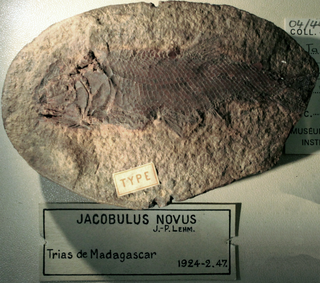
Carcharhinus is the type genus of the family Carcharhinidae, the requiem sharks. One of 12 genera in its family, it contains over half of the species therein. It contains 35 extant and eight extinct species to date, with likely more species yet to be described.

Hapalops is an extinct genus of ground sloth from the Early to Late Miocene of Brazil, Bolivia, Colombia, and Argentina in South America.
Batrachosuchoides is an extinct genus of prehistoric amphibian from the Early Triassic of Russia. It was found in the Baskunchakskaia Series and the Lestanshorskaya Svita.
Batrachosaurus is an extinct genus of prehistoric brachyopoid amphibian that lived in Germany during the Middle Triassic (Ladinian). The genus was named by Joseph Fitzinger in 1837 and the type species, B. jaegeri, was named three years later in 1840. It may have been the same animal as Mastodonsaurus.

Jacobulus is an extinct genus of prehistoric ray-finned fish that lived during the Early Triassic epoch in what is now northern Madagascar 252.3 to 251.3 million years ago. The type species is Jacobulus novus (monotypy). It was a small fish less than 10 centimetres (3.9 in) in length. J. novus ecology was a grazer-detritivore. It belongs to the Parasemionotidae together with Albertonia, Candelarialepis, Icarealcyon, Lehmanotus, Parasemionotus, Qingshania, Stensioenotus, Suius, Thomasinotus, and Watsonulus.
Gosfordia is an extinct genus of prehistoric lungfish known from the Triassic of Australia.
Ganopristodus is an extinct genus of prehistoric sarcopterygian or lobe-finned fish from the Devonian.
Euporosteus is an extinct genus of prehistoric sarcopterygian or lobe-finned fish.
Lochmocercus is an extinct genus of prehistoric coelacanth fishes which lived during the Carboniferous Period.
Howidipterus is an extinct genus of prehistoric sarcopterygian or lobe-finned fish.
Hamodus is an extinct genus of prehistoric sarcopterygian or lobe-finned fish.
Metaceratodus is an extinct genus of prehistoric lungfish in the family Ceratodontidae, with an indeterminate specimen known from the Late Triassic (Norian)-aged Lissauer Breccia of Poland and more complete specimens known from the Late Cretaceous of Queensland, Australia and Argentina. The genus was named and described by Frederick Chapman in 1914.

Ptychoceratodus is an extinct genus of lungfish living from Early Triassic to Middle Jurassic. It was established by Otto Jaekel for one species, transferred from Ceratodus genus. Type species is P. serratus from the Middle Triassic of Switzerland and Germany. Ptychoceratodus had two pairs of massive dental plates, bearing 4-6 acute ridges. Its skull roof was composed from massive, plate-like bones. In the central part of skull roof was localized an unossified fenestra. Most of the Ptychoceratodus findings are isolated dental plates, some associated with jaws. Other parts of skull or postcranial skeleton are relatively rarely found as fossils. The anatomy of skull is the best recognized in P. serratus, whereas less complete cranial material is available also for P. concinuus, P. phillipsi, and P. rectangulus. Although Ptychoceratodus is known exclusively from the Triassic and Jurassic, there were also Cretaceous specimens referred to this genus. However, they are more often regarded as representants of Metaceratodus. Ptychoceratodus is the only member of the family Ptychoceratodontidae. The first named species is P. phillipsi by Louis Agassiz in 1837 as a species of Ceratodus and later moved to the genus Ptychoceratodus. Occurrences of Ptychoceratodus come mainly from Europe. However, occurrences from other continents suggest it was dispersed globally during the Triassic. After 2010, the new fossil material behind the Europe was reported from South America, India, and Greenland
Proceratodus is an extinct genus of prehistoric sarcopterygians or lobe-finned fish.

Porolepis is an extinct genus of porolepiform sarcopterygian fish, from the Early Devonian Dniester Series of Ukraine, which is rich in Porolepis remains, and also the Nellen Koepfchen Beds of Germany. It lived alongside the dubious lophotrochozoan Macrodontophion. It was first described in 1858 but Porolepis was not named as a sufficient species until 1891.

Paraceratodus is an extinct genus of prehistoric lungfish. Only one species, P. germaini, is known from the latest Permian or earliest Triassic period of Madagascar. Phylogenetic evidence supports it being the most basal member of the suborder Ceratodontoidei, which contains modern lungfish, and as with the rest of the order it likely diverged during the late Carboniferous.
Orlovichthys is an extinct genus of prehistoric sarcopterygians or lobe-finned fish. Fossil evidence was found in Russia, and is from the Late Devonian period.
Tranodis is an extinct genus of prehistoric sarcopterygians or lobe-finned fish. It was a lungfish from the Upper Mississippian of North America.

Rhadinichthys is an extinct genus of prehistoric bony fish. It is known from several species that lived in the Late Devonian epoch, the Carboniferous period and the Cisuralian epoch in what is now Europe, South Africa, and North and South America. Some isolated scales from the Cisuralian of Europe were also referred to this genus.
Hiskatherium is an extinct genus of small ground sloth from the Middle Miocene Honda Group of Bolivia. The type species H. saintandrei was named in 2011 on the basis of a lower jaw. Although it has not been placed in a specific family, Hiskatherium is similar to the extinct sloths Hapalops and Xyophorus.










